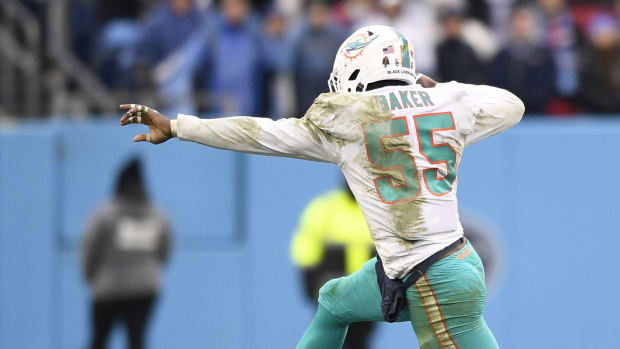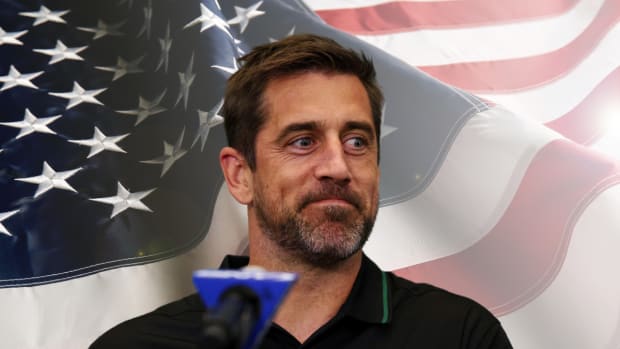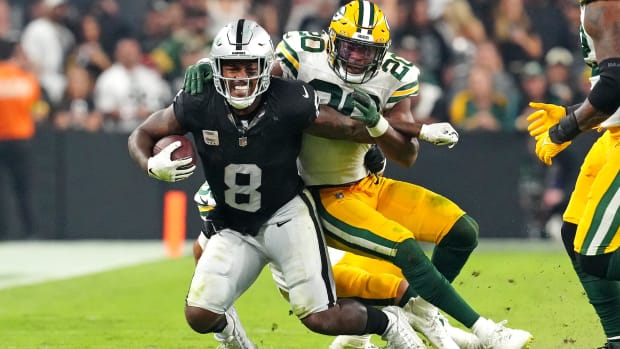
Blame Jordan Love, Everyone Else for Struggling Packers Passing Game
GREEN BAY, Wis. – Is Jordan Love to blame for the state of the Green Bay Packers’ passing game? Is it the receivers’ fault? How about Matt LaFleur and the coaches? Or general manager Brian Gutekunst?
Yes, yes, yes and yes.
Entering Sunday’s game against the Los Angeles Rams, Love out of 33 qualifying quarterbacks ranks 32nd in completion percentage, 28th in interception percentage and 26th in yards per attempt. Throw all the numbers into the soup and you get a 28th-ranked passer rating of 78.1.
Even those feeble numbers are out of whack. After throwing six touchdowns and zero interceptions in the first two games, Love among the 29 quarterbacks who’ve thrown at least 100 passes since the start of Week 3 is last with a passer rating of 66.6, tied for last with a 58.2 percent completion rate, second-to-last with 6.0 yards per attempt and a 4.4 percent interception rate, and last with eight interceptions.
The Packers have failed to score more than 20 points in five consecutive games, their longest streak since 2005. Love has tossed at least one interception in each of those games.
In what everyone knew would be a work-in-progress season following the offseason trade of Aaron Rodgers and the free-agent departure of Allen Lazard and Robert Tonyan, among others, where’s the progress?
“You’ve just got to measure it every day,” Love said. “It’s a process. I know it’s a process. I know it’s not going to be perfect right away. I try and focus on it day by day, making sure that I’m getting better, going in the right direction, learning from mistakes and just continue to grow as a player and as a leader of the team in every role. Just trying to get better every day, but it’s definitely a process.”
Blame Everyone Else
Love has thrown too many inaccurate passers and made too many questionable decisions for the Packers to score points and win games.
He’s also incapable of picking up blitzes and catching his own passes.
“Offensive football, you need 11 guys to do their job and, if one guy doesn’t or is off a little bit, it can impact the whole play,” longtime quarterbacks coach Tom Clements said.
There have been a lot of instances of players not doing their job.
- Of 34 quarterbacks with at least 100 dropbacks, Love has been victimized by the third-highest drop rate, 8.8 percent, according to Pro Football Focus.
- Combined, according to PFF, every player on the Packers roster has made nine contested catches out of 43 opportunities. Essentially, on 50/50 balls, everyone from Romeo Doubs (5-of-13) to Christian Watson (0-for-8) to Josiah Deguara (1-for-1) has caught 20.8 percent of those chances.
For sake of comparison, receiver D.J. Moore, who was acquired by the Bears before the draft, has caught 11-of-16.
“You always can be better there,” offensive coordinator Adam Stenavich said. “I think No. 1, that starts with the attitude of the guy going up for the ball. ‘It’s either mine or nobody’s.’ We practice that a lot actually where we’re working on fades and stuff like that. I think Romeo’s done a really good job in those situations. But, yeah, everybody, it all starts with a mindset of just going up there and attacking that ball.”
- There are no publicly available numbers to judge missed assignments. There have been obvious ones, such as two players in the same spot, and not-so-obvious ones, such as the 32-yard completion to Jayden Reed last week that could have been a lot bigger had he taken his route up the numbers.
“I don't want him to look out there and think a guy has to be there at 10 yards and he's at 12 or he's at 14,” receivers coach and passing-game coordinator Jason Vrable said. “We can't be having that stuff and it's happened at times, and that might make Jordan look not as confident.”
Blame Jordan Love
While all those things are true, there’s no doubt Love is part of the problem, too. Yes, receivers have dropped his passes but he’s not alone.
- PFF has a stat called adjusted completion percentage, which ignores throwaways and turns drops into completions. Love’s adjusted completion percentage of 66.4 is still the second-worst in the NFL.
For context, that in-a-perfect-world completion rate would rank just 16th in real-world percentage. For unfair context, Vikings quarterback Kirk Cousins’ actual completion rate of 69.4 percent ranks fifth in the league and is better than Love’s adjusted completion percentage even while being victimized by a league-high 20 drops.
“I think he’s an accurate passer,” Clements said. “He makes some very good throws. Obviously like anyone he misses some throws, and sometimes it could be under pressure, sometimes it could be the receiver routes, sometimes it could be him. All those things factor in. But just as a general statement, I think he’s an accurate passer.”

Jordan Love has thrown five touchdowns vs. eight interceptions the last five games.
Photo by Tork Mason/USA Today Sports Images
- To be sure, Love’s percentage is impacted by his number of downfield passes. Even with a more conservative approach the last few weeks, Love’s air yards per attempt of 9.32 is the second-longest. However, of 33 quarterbacks who’ve thrown more than 40 passes between 0 and 9 yards downfield, Love is 32nd with a 70.1 completion percentage. For comparison, rookie Bryce Young has completed a league-high 90.0 percent of those throws.
- The offensive line hasn’t been great, especially the last handful of games, but PFF has judged Love to be under pressure on 29.8 percent of his dropbacks. Of 32 quarterbacks who’ve faced at least 50 pressures, that’s the fourth-lowest in the league. He just hasn’t handled it well, ranking 28th in completion percentage (42.1) and 29th in passer rating (47.0).
- Defensive coordinators have taken a conservative approach to facing Love. Typically, they rush four and drop seven into zones. Zone defense limits a quarterback’s running ability and forces the quarterback to make the right read in a timely manner.
Take last week’s game against the Vikings as an example. Minnesota blitzed early and often against San Francisco’s Brock Purdy (63.6 percent in Week 7), Chicago’s Justin Fields (70.6 percent in Week 6) and Kansas City’s Patrick Mahomes (55.8 percent in Week 5) the previous three games. The Vikings blitzed Love 40.8 percent of the time on Sunday.
As one scout who studied Love for an upcoming game said, “You watch him, he’s slow through his reads and you’re thinking, ‘We’re going to get three picks against this guy.’”
- Cousins put on a clinic against the Packers. Time and again, his first reads were covered. But, with the rush closing in, he found his checkdown. Those easy passes led to Cousins completing 74.2 percent of his passes for a robust 8.84 yards per attempt.
“What comes with experience is just when the pocket gets a little bit muddy, it’s either how do I get out of it or where’s my checkdown?” LaFleur said. “There were many times when we got pressure on Kirk and he was able to, right before the rush was about to hit him, he was hitting these checkdowns and they were coming up big for him.”
Blame Matt LaFleur and Brian Gutekunst
Of course, Love’s struggles come with the enormous asterisk of being a first-year starting quarterback throwing the football to nothing but rookie and first-year receivers.
(Of course, that comes with the enormous asterisk of which veteran receiver was going to help the Packers. Remember that Lazard – a player fans were all too happy to get rid of – was the best receiver on the market, and Randall Cobb was a mid-tier option.)
Going young was Gutekunst’s vision. Letting Love grow alongside his young receivers makes perfect sense. For this team to make a move in 2024 and potentially contend in 2025, let Love, Doubs, Watson and the others gather as much experience as possible in 2023.
The byproduct of going young is what you’ve seen the last five games.
The complete and total inability for the coaches to come up with a game plan capable of gaining even a few first downs to start games has been an enormous problem. It’s impossible to build rhythm in three-play increments.
Moreover, a successful running game is built one rushing attempt at a time. It’s been impossible to get the running game going when third-and-long becomes a three-and-out punt.
“We have a lot of young guys, and that’s the plan is to be able to build this thing and go in the right direction,” Love said. “We all knew it was going to take time. It wasn’t going to be perfect right off the bat. Obviously, at this point, it’s still a work in progress. We’re still working and building to that every day, trying to get better as a unit and as a group.
“Yeah, it’s a little slower to start than we expected. Right now, it’s about finding ways to get better every day and keep moving in the right direction.”
More Green Bay Packers News
Could Rich Bisaccia return to Raiders?





